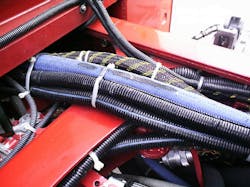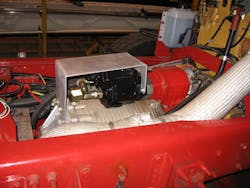Purchasing fire apparatus can be a complex and time-consuming process. This process involves five phases, each of which can be a lengthy discussion of their own:
- Initial Phase: Identification of funding and needs
- Specification Phase: Preparation of specification
- Bidding Phase: Out to bid and evaluation of proposals
- Build Phase: Engineering and manufacturing
- Acceptance Phase: Vehicle delivery (with all equipment) and required third-party testing complete
This discussion will focus on the Build Phase, which consists of the pre-construction meeting (sometimes referred to as the engineering meeting) and the on-site inspections. The pre-construction meeting is the foundation to the success of the “build” process. The on-site inspection is the insurance that the vehicle is being engineered and built as specified.
Meeting and inspection basics
It is optimal to limit the inspection team to three or four individuals: the project manager, an end-user, a service technician (or person who manages service and repairs) and the specification writer.
Communication between the department and the manufacturer is critical to the success of the project. It should be made clear to all parties that the project manager is the point of contact for the department. Similarly, communication from the manufacturer should come from one identified individual. All communication should be funneled between these two parties, and then distributed out to the appropriate people.
Pre-construction meeting
The pre-construction meeting is critical, as all parties involved (department and manufacturer representatives) should leave the meeting with a mutual understanding of what the vehicle will “look” like. In other words, department representatives should define the intent of their specifications, and manufacturer’s representatives should define their interpretation of the specifications. By the end of the meeting, solutions to any discrepancies between the two parties’ interpretations should be agreed to, and the design team should have all the information necessary to complete the final design prints and build order.
The factory is the best location for the pre-construction meeting. This allows for the department representatives to meet the engineering team that will be working on the project. It also allows the department representatives to walk the factory floor and witness first-hand how the vehicle will be built. Questions that arise can be answered by walking out to the floor and viewing vehicles under construction. Department representatives can view available options for consideration as well. Allot two full days for the meeting.
Unfortunately, it can be sometimes difficult for departments to assemble a team to attend the pre-construction meeting at the factory. If this situation arises, the meeting may be held at the dealer’s facility or at the department’s location. In either case, it is beneficial for a factory representative to attend the meeting along with the dealer’s representative.
Prior to attending the meeting, a careful review of the bidder’s proposal and the specification should be done by all department representatives scheduled to attend the meeting. Any questions that arise should be forwarded to the manufacturer so they can be researched prior to meeting. An equipment list should be assembled by the department reps, offering a general idea of where each piece of equipment will be carried on the vehicle. These department reps should also take pictures of current apparatus, lettering, logos, and special equipment that will be used as references at the meeting.
At the actual meeting, the representatives should review the specification line-by-line. All members should take detailed notes and compare notes prior to adjourning the meeting. It is critical that the project manager keep the team on task at the meeting, keeping interruptions to a minimum. A list of unresolved issues should be developed by the project manager and reviewed with all parties (department reps and manufacturer reps). Additionally, the project manager should review the lines of communication with the department reps and the manufacturer reps to ensure information flows through the correct channels.
After the meeting, the project manager develops answers to the unresolved issues in a timely manner. The manufacturer needs all of these issues resolved so they can complete the design and engineering of the vehicle.
Mid-construction inspection
Sometimes referred to as a “chassis inspection,” the mid-construction inspection takes place as the vehicle is moving down the assembly line. The window of opportunity to inspect the vehicle as it is moving down the line falls into a relatively small time period. Manufacturers are reluctant to pull the vehicle off the line to wait for an inspection team to arrive to inspect the vehicle. Therefore, communication with the manufacturer is critical to plan ahead for this short window of opportunity to inspect the vehicle. Don’t skip the inspection, and don’t simply use pictures supplied by the factory in place of the actual trip to the factory. Ideally, the same people who attended the initial pre-construction meeting should attend this inspection trip.
There are different opinions regarding the precise timing of this inspection. Some people like to see the vehicle with the body off so they can inspect the chassis top to bottom. I believe that the optimum time to inspect the vehicle is shortly after the body has been mounted on the chassis. This allows the inspection team to have a good visual of what the completed vehicle will look like. Teams can more accurately identify locations for accessories, verify compartment shelving, and determine other component locations with the more accurate spatial awareness available with the mounted body in place.
Once again, the team should do a line-by-line review of the specification, this time on the manufacturer’s floor next to the vehicle. In addition to a quality-control inspection, inspectors review the components to verify that what is specified is actually being supplied. Any deficiencies should be noted for correction by the project manager. Allot two full days for this inspection. Prior to leaving the factory, the project manager should review the list of the items noted for correction with the factory representatives.
Potential changes, modifications or additions to the vehicle (often referred to as change orders) may arise during this inspection trip. More often than not, there is a cost associated with these. Prior to leaving the factory, or very soon thereafter, the manufacturer should provide a list of these change orders and their associated costs. The project manager should make a decision regarding whether these change orders are going to be implemented prior to leaving the factory. If no decision is made at the factory, then it should be very soon afterward, as the vehicle is moving down the assembly line at a fairly rapid pace. In general, changes made at this time in the build process will be cheaper than changes requested at the final inspection.
Finally, before leaving the factory, the project manager should review all the issues, changes and modifications with the factory representative to ensure everybody has the same information.
Final inspection
When the vehicle is off of the assembly line, the team should conduct a final inspection at the factory. If a team cannot be assembled to travel to the factory, they can inspect the vehicle at the dealer’s facility; however, this is not ideal because the factory has all the available tools to change, modify or repair whatever needs to be done prior to the vehicle leaving the factory.
Once again, the specification should be reviewed and compared with the vehicle on the inspection floor. All the changes, modifications or corrections noted at the mid-construction inspection should be verified as complete by the department reps. The vehicle should be driven, and all systems should be operated by the department reps to ensure functionality. The department reps should review the third-party testing results if they were not witnessed by the inspection team.
The team should allow two full days for the final inspection. Prior to leaving the factory, the department reps should review the issues, changes and modifications with the factory representative to ensure everybody has the same information.
The who, what, when and where the vehicle is going to be delivered should be determined by the project manager. Normally, the vehicle is delivered to the dealer, and the dealer preps the vehicle prior to delivering it to the department. If possible, the vehicle should be inspected at the dealer’s facility to ensure all the issues noted at the final inspection were addressed prior to delivery.
Guidelines for success
Personnel continuity throughout the duration of the apparatus purchasing process is essential. At least one person should be involved throughout the entire process so a historical knowledge base can be developed. That historical knowledge base will be the foundation for a successful project.
Identifying a project manager and establishing communication flow is critical to the success of the project. Following the established communication flow will minimize confusion and misunderstandings that can arise when multiple people are allowed to communicate amongst themselves without the supervision of the project manager. Meticulous documentation by all involved parties will minimize, if not eliminate, any misunderstandings between the department and the manufacturer.
Careful consideration should be placed on the selection of the people who are involved in the pre-construction meeting and the inspections. It must be stressed that these trips to the manufacturer’s facility are work trips that require all parties to act professionally while representing their department and work tirelessly to ensure the vehicle is manufactured as specified.
Lastly, developing a professional relationship with the manufacturer’s representative will allow for open dialogue among all the individuals involved in the project. Differing interpretations of the specification often arise and a solution to the disagreement can more easily be arrived at when the parties trust each other and avoid an adversary attitude.
About the Author

Greg Stone
Greg Stone is a retired 33-year veteran of the Los Angeles Fire Department. His assignments with the department included apparatus and equipment purchasing responsibilities. Additionally, Stone has 25 years of apparatus purchasing experience assisting other departments with their purchasing needs.

